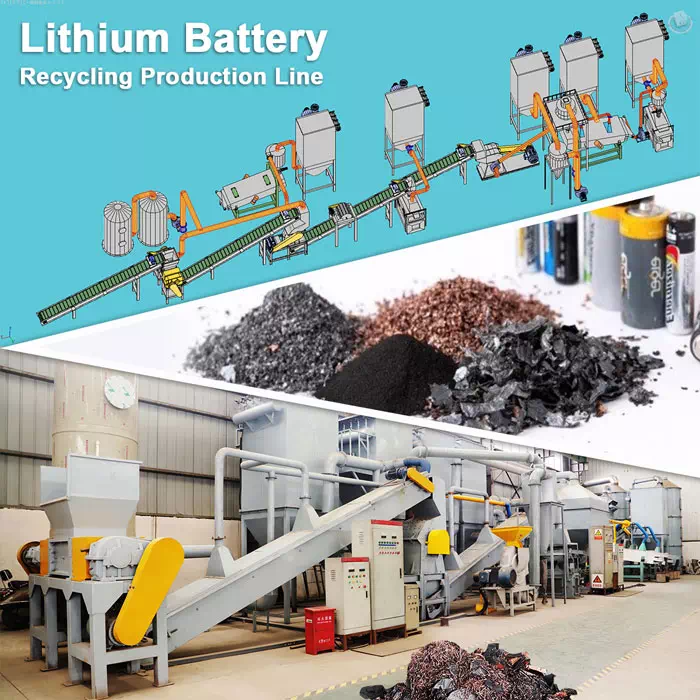Lithium-ion battery recycling technology
Lithium-ion battery consists of positive electrode, negative electrode, electrolyte, separator, current collector, shell and other parts. Mix the positive electrode material, conductive agent and organic binder of the battery evenly and apply it to both sides of the aluminum foil current collector. Mix the negative electrode material, conductive agent and organic binder evenly and apply it to both sides of the copper foil current collector. The separators are separated, all immersed in an organic electrolyte, and finally wrapped with a casing. Waste lithium-ion batteries must be completely discharged before recycling to ensure that there is no harm to the human body, and then disassemble, remove the outer casing, separate the positive and negative electrode materials, current collectors, electrolytes, etc., and then proceed to the next step of recycling.
Recycling of lithium-ion battery shells, lithium battery shells include steel shell (square type is rarely used), aluminum shell, nickel-plated iron shell (used for cylindrical batteries), aluminum-plastic film (soft packaging), etc., as well as the cap of the battery, that is, the battery Positive and negative terminals. Before recycling the shell, the waste lithium battery needs to be discharged and pretreated before it can be disassembled. The disassembled plastic and iron shell can be recycled. Usually there are: mechanical crushing and screening method, that is, through mechanical crushing, sieving, and sorting out the shell material.
Cathode material recycling
Lithium-ion batteries use lithium-containing compounds as the positive electrode, with only lithium ions and no metal lithium. Usually lithium manganate, lithium cobalt oxide, lithium iron phosphate, lithium nickel cobalt manganate and other materials, most of the active material of lithium ion battery cathode still uses lithium cobalt oxide, because lithium nickel cobalt manganate combines with lithium manganate The advantages of both materials and lithium cobalt oxide have attracted the interest of many researchers, and it has great potential as a power battery for electric bicycles and electric vehicles.
With the depletion of such non-renewable mineral resources, and the positive electrode material accounts for 40% of the total cost of the battery, if the heavy metals such as cobalt, nickel, and lithium in the positive electrode material are effectively recovered, waste will be turned into treasure, and the recycling of materials will be realized. It can not only alleviate the crisis of mineral resources and achieve sustainable development, but also bring huge economic benefits.
Recycling of anode materials
There are many types of negative electrode materials for lithium batteries: ① Metal materials, such as lithium metal. ②Inorganic non-metallic materials, mainly carbon materials, silicon materials and other non-metallic composite materials. ③ transition metal oxides. At present, carbon, graphite and non-graphite carbon materials are widely used. Due to its excellent cycle life, safety and rate performance, lithium titanate can also be used as a negative electrode material in electric vehicles.
The mutual peeling between the carbon powder and the copper foil is effectively achieved by hammer crushing, and then the copper foil and the carbon powder are preliminarily separated according to the vibration sieving of the difference in size and shape between the particles. The copper foil is enriched in the particle size range greater than 0.250 mm and the carbon powder is enriched in the particle size range of less than 0.125 mm, which can be directly recycled according to the particle size. For broken particles with a particle size of 0.125-0.250 mm, the air separation method was used to achieve effective separation between copper and carbon powder. The resource utilization of metal copper and carbon powder in the negative electrode material of waste lithium battery can be realized by the combined process of hammer crushing, vibration screening and air separation.
Recovery of Organic Electrolyte and Separator
After the electrode and separator are soaked in a suitable solvent for a certain period of time, the electrolyte will be completely removed into the solvent. Polycarbonate (PC) has a relatively large relative permittivity, which is conducive to the dissolution of lithium salts. After soaking the electrolyte and separator in PC solvent for a period of time, the recovered electrolyte LiPF6 can be reused in the battery.
With the development of science and technology, lithium batteries have been greatly improved in terms of safety and service life, but the recycling of lithium batteries has not kept pace. With the overall increase in demand for new energy vehicles, lithium-ion batteries will be in short supply. If there are only battery manufacturers, no battery recycling institutions, and nowhere to dispose of waste batteries, the development of new energy will lose its original meaning. The recycling and reuse of power lithium-ion batteries is imminent. In short, the realization of the sustainable development of lithium batteries is closely related to alleviating the energy crisis, ecological environment, energy conservation and emission reduction, which is beneficial to the country and the people, and has a huge role in promoting industrial development.




